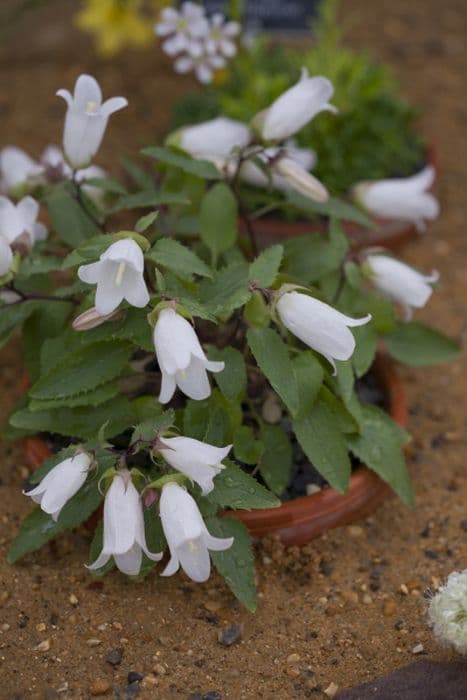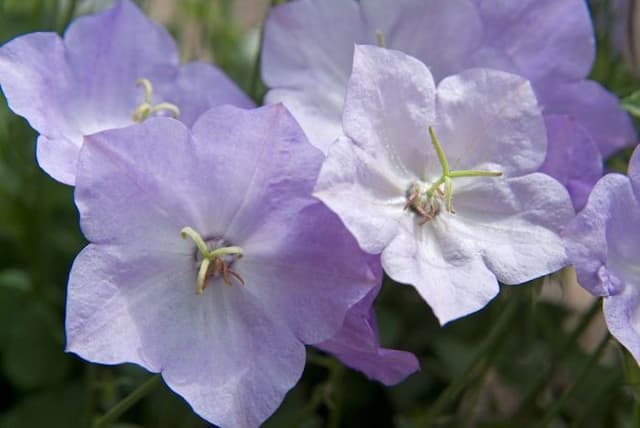Pink Octopus Bellflower Campanula 'Pink Octopus' (PBR)

ABOUT
The Campanula 'Pink Octopus' is distinguished by its eye-catching flowers that resemble the tentacles of an octopus. The petals are elongated, narrow, and curl at the ends, creating a whimsical look as if they are reaching outwards like the arms of an octopus. These petals are a soft pink color, adding a gentle pop of color to the garden. The base of each flower is a deeper, more vibrant pink, which gradually fades to a lighter shade at the tips of the twisted petals. The blossoms are borne on loose, sprawling stems that cascade gracefully, adding movement and interest to their surroundings. This plant has a clumping habit, meaning it grows in a compact group, creating a tidy and full presentation of foliage and flowers. Its leaves are green, often with a slightly serrated edge, and provide a lush backdrop for the playful flowers. As a whole, the 'Pink Octopus' presents as a delightful addition to any outdoor space, offering a unique form of beauty with its characteristic blooms that invite observation and curiosity.
About this plant
 Names
NamesFamily
Campanulaceae
Synonyms
Pink Octopus Bellflower, Octopus Bellflower
Common names
There are no synonyms for the scientific name Campanula 'Pink Octopus' (PBR); this is the unique name for this particular cultivar.
 Toxicity
ToxicityTo humans
The Pink Octopus Bellflower is not known for being toxic to humans. Therefore, ingestion of this plant typically does not result in poisoning or adverse health effects. However, it is generally advised to avoid eating ornamental plants due to potential risks of pesticides or other chemicals that may be present on or in the plant.
To pets
The Pink Octopus Bellflower is not known to be toxic to pets. It is not listed among plants that pose a risk of poisoning to common household pets such as dogs and cats. However, it is still wise to prevent pets from eating plants as a precautionary measure. If a pet ingests large amounts of the plant and does show signs of distress, consult a veterinarian as there could be other reasons for the pet's reaction.
 Characteristics
CharacteristicsLife cycle
Perennials
Foliage type
Deciduous
Color of leaves
Green
Flower color
Pink
Height
1 foot 4 inches (40 cm)
Spread
1 foot 8 inches (50 cm)
Plant type
Herb
Hardiness zones
5
Native area
Asia
Benefits
 General Benefits
General Benefits- Attracts Pollinators: The 'Pink Octopus' plant attracts bees and butterflies, which are necessary for the pollination of many other plants.
- Easy to Grow: This variety is known for being easy to care for, making it a great choice for gardeners of all skill levels.
- Unique Flower Shape: The unusual octopus-like petals add an interesting visual element to any garden or floral arrangement.
- Drought Tolerant: Once established, the 'Pink Octopus' is relatively drought resistant, making it suitable for xeriscaping.
- Long Blooming Period: It has a lengthier blooming period compared to some other perennials, offering color for an extended time during the growing season.
- Compact Size: The plant grows to a manageable size which makes it perfect for borders, pots, or small gardens.
 Medical Properties
Medical PropertiesThis plant is not used for medical purposes.
 Air-purifying Qualities
Air-purifying QualitiesThis plant is not specifically known for air purifying qualities.
 Other Uses
Other Uses- Art Inspiration: The unique 'pink octopus' petals of the Bellflower can inspire artists and designers for patterns in textiles, wallpapers, or even jewelry designs.
- Photography Subject: Its distinctive shape makes it a captivating subject for botanical photographers and hobbyists looking to add interest to their photo collection.
- Fairy Gardens: The whimsical nature of the Bellflower 'Pink Octopus' makes it an ideal plant for creating enchanting fairy gardens.
- Education: The flower can be used in botanical studies to illustrate the diversity of the Campanulaceae family and the concept of plant breeding.
- Culinary Garnish: Although not widely known for culinary uses, the flowers could be used as an edible garnish to add color to salads or desserts (always verify edibility first).
- Themed Events: The Bellflower 'Pink Octopus' can be used as decor for marine- or ocean-themed events due to its tentacle-like petals.
- Bee Gardens: Planting the Bellflower 'Pink Octopus' can help attract bees for gardeners who are looking to support pollinator populations.
- Writing Inspiration: The plant's unique appearance can serve as inspiration for writers creating fantasy worlds or describing otherworldly flora.
- Color Dye: Petals can potentially be used to create natural dyes for small craft projects, though the color fastness and intensity would need to be tested.
- Study of Adaptation: The Bellflower 'Pink Octopus' can be a subject in discussions or studies on how plants adapt and evolve for pollination or survival advantages.
Interesting Facts
 Feng Shui
Feng ShuiThe Bellflower is not used in Feng Shui practice.
 Zodiac Sign Compitability
Zodiac Sign CompitabilityThe Bellflower is not used in astrology practice.
 Plant Symbolism
Plant Symbolism- Gratitude: Campanula flowers, commonly known as Bellflowers, often symbolize gratitude, likely due to their bell shape that can be associated with communication and the act of 'ringing' someone to give thanks.
- Constancy and Perseverance: These plants are known for their hardiness and ability to thrive in a variety of conditions, thus embodying the qualities of constancy and perseverance in the face of adversity.
- Unwavering Love: The long-lasting nature of the Bellflower's blooms has made it a representation of unwavering and endless affection, signifying a love that stands the test of time.
- Humility: The shape of the flower, hanging like a bell, gives off a humble appearance, and as a result, it can symbolize humility in various cultural contexts.
 Water
WaterThe Bellflower 'Pink Octopus' prefers soil that is consistently moist but never soggy. Water these plants deeply to encourage root growth, providing about one gallon of water per week, depending on weather conditions. During hot and dry spells, you may need to water the plants more frequently, especially if they are grown in containers. Reduce watering in the winter months when the plant's growth naturally slows down. It's important to avoid overhead watering to prevent leaf diseases; instead, water at the base of the plant.
 Light
LightBellflower 'Pink Octopus' thrives in full sun to partial shade. The ideal location provides morning sun and afternoon shade, particularly in hotter climates. Too much shade can result in fewer blooms and leggy growth, while too much direct sun, especially in the afternoon, can lead to scorching of the leaves.
 Temperature
TemperatureThe Bellflower 'Pink Octopus' can tolerate a temperature range between 40 to 85 degrees Fahrenheit, with their preferred growing temperature sitting between 60 to 75 degrees Fahrenheit. They can tolerate a light frost but sustained temperatures below freezing can damage or kill the plant.
 Pruning
PruningPruning the Bellflower 'Pink Octopus' is done to maintain its shape, encourage bushier growth, and promote more blooms. Deadhead spent flowers regularly to stimulate new blooms. Prune back the plant after flowering has finished in late summer or early fall, cutting stems back to the base of the plant to tidy it up and encourage new growth for the following year.
 Cleaning
CleaningAs needed
 Soil
SoilThe Pink Octopus Bellflower thrives best in a well-draining soil mix with a neutral to slightly alkaline pH of around 7.0 to 7.5. A good mixture could be composed of equal parts loam, peat moss, and perlite or sand to ensure proper drainage and aeration. Regular compost or well-rotted manure can be added to provide nutrients.
 Repotting
RepottingPink Octopus Bellflower should be repotted every 2-3 years or when it becomes root-bound. Spring is the ideal time for repotting, allowing the plant to adjust in the growing season.
 Humidity & Misting
Humidity & MistingPink Octopus Bellflower prefers moderate humidity levels, but it can tolerate a wide range of conditions. No specific humidity level is necessary; however, avoiding excessively dry air will help prevent leaf tip browning.
 Suitable locations
Suitable locationsIndoor
Place in bright, indirect light and water when soil feels dry.
Outdoor
Plant in partial shade or sun, and well-draining soil.
Hardiness zone
3-8 USDA
 Life cycle
Life cycleThe Campanula 'Pink Octopus' (PBR), commonly known as Pink Octopus Bellflower, starts its life cycle as a seed, which upon germination, develops into a small seedling. The seedling grows into a vegetative plant with a rosette of basal leaves, and as it matures, it establishes a robust root system. In its flowering stage, typically in late spring to early summer, the Pink Octopus Bellflower produces long, upright stems bearing distinctive pink, octopus-like flowers with narrow, elongated petals. After pollination, often by bees or other insects, the flowers produce fruits containing seeds, completing its reproductive cycle. The plant may continue to grow and spread vegetatively as well, with clumps expanding each year. In colder climates, the Pink Octopus Bellflower becomes dormant in the winter, dying back to the ground before re-emerging in spring.
 Propogation
PropogationPropogation time
Spring-Early Summer
The Campanula 'Pink Octopus', commonly known as Bellflower 'Pink Octopus', is typically propagated through division, which is its most popular method. This can be done in either spring or early fall. To propagate by division, gently lift the plant from the ground with a garden fork, taking care not to damage the root ball. Once the plant is out, use a sharp knife or spade to divide it into smaller sections, ensuring that each section has a portion of the root system attached. Replant these divisions immediately into prepared soil, spacing them about 12 inches (approximately 30 centimeters) apart to give them ample room to grow. Water the new plants thoroughly to help establish them. This technique allows gardeners to create new plants that are genetically identical to the parent plant, maintaining the distinctive features of the 'Pink Octopus' variety.









![Milky bellflower [Avalanche]](/_next/image?url=https%3A%2F%2Fplants-admin.emdemapps.com%2Fimages%2Fplants%2F%2Fimages%2F604b5dc88c1e7.png&w=640&q=75)